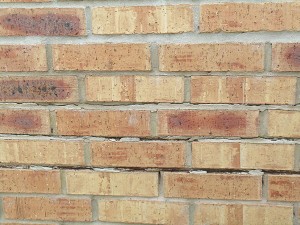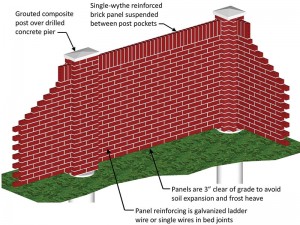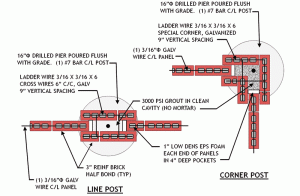Question
I have observed many brick fences throughout the west and southwest. Most are in excellent condition, but some require repair or reconstruction. Can you explain the variation in performance and how best to design them?
Answer
In the 1970s, Acme Brick Company developed a design for building thin brick fences with a single layer of clay brick in panels suspended between reinforced brick posts on drilled piers. Panels are reinforced with joint reinforcing, which is designed to carry wind loads and the much lower stresses from gravity loads on the brick. Typical panels span between posts that are 10 to 12 feet on center.
Hundreds of miles of these fences have been built in Texas, as well as in other parts of the country. Many of those fences show no signs of distress after 20 or more years of wind and weather exposure. Properly designed, we expect them to last fifty years or more. But there are also a number of fences that have deteriorated in ten years or less, and must be replaced. That deterioration has occurred because those who built the fences either did not understand the design or did not use the right materials and workmanship.
The Panel and Post System
Figure 1 shows a perspective view of the major components of the fence system.
Posts are built with two faces of clay brick tied together with wire reinforcing (Figure 2). The design calls for 3/16-inch diameter wire that is either hooked on the ends or welded as ladder wire to engage the brick faces. A core of grout is formed and poured between the brick faces to create a composite post that carries wind loads in bending to a drilled concrete pier. Pockets are formed approximately three inches deep on each side of the posts to receive the reinforced brick panels.
Panels are isolated from the posts with compressible foam to prevent hard contact between them that could cause crushing or spalling with differential movement. Panels are typically laid in place on temporary forms and remain three inches clear of the ground or mud slabs below. Wire reinforcing in the bed joints is designed to resist out-of-plane bending from wind loads. Vertical bending stresses from the weight of the brick are typically about one percent of the wind load stresses, so they are not significant to the design.
Requirements for Strength and Durability
Strength requirements are straightforward:
- Piers must be drilled deep enough to resist overturning loads from wind on the panels and posts in the soils encountered at the site. NCMA TEK 14-15A provides some guidance for pier design to resist wind loads, but soil types vary widely and may require deeper piers.
- Posts must be sufficiently reinforced and grouted to carry overturning wind loads to the drilled concrete piers below.
- Pier reinforcing need not be more than a single bar in the center, since shear loads are low and shear reinforcing is not necessary.
- Panels can be either prefabricated or laid up onsite, but must have reinforcing designed for the wind loads.
- Panel reinforcing must have sufficient cover to prevent corrosion. The masonry code and specification (TMS402/602) requires 5/8-inch cover. This may be difficult or impossible to achieve with 2-5/8-inch brick and ladder wire. Consider a single wire at the centerline for these bricks.
- Reinforcing wire must be hot-dip galvanized or stainless steel to prevent corrosion.
- Steps must be taken to assure adequate bond between brick and mortar and between mortar and reinforcing. Oil must be removed from stainless steel wire.

Figure 3. Fence breaking apart from corrosion of joint reinforcing. Fence was less than 2 years old at time of photograph in 2005, Austin, TX.
When Things Go Wrong
There have been a number of failures of fence panels (Figure 3). These are seen as cracks developing between mortar and brick. As cracks progress, mortar spalls off and rusted reinforcing appears near the surface. This can result from one or more of the following causes:
- Poor bond between brick and mortar.
- Insufficient cover on wire reinforcing.
- Wire reinforcing may not be hot-dip galvanized after fabrication.
Poor mortar bond can result from using mortar with too high an air content. For that reason, portland-lime Type S mortar is recommended, but good results can be achieved with high quality masonry cements as well. Workmanship plays the most critical role in achieving mortar bond, including timely placement of brick after stringing mortar, proper moisture content and workability of mortar, and pre-wetting of certain brick that have high initial rates of absorption. There is also a potential for failure if mortar is over-sanded. When bond is poor, a crack can develop between brick and mortar that allows a path for water to reach the wire reinforcing and cause corrosion.
One way to assure that the bricklayer will achieve good mortar bond is to design the panels without shelf angles supporting the bottom course. If the panels are built on temporary forms, which are removed after 1 to 3 days, any brick that are not properly bonded will fall off the bottom of the panel when the forms are removed. This is an early quality test for the bricklayer’s workmanship. But many fence builders insist on laying the brick on steel angle lintels at the bottom of the panels. Those lintels keep any poorly bonded brick from falling off, and it may take several years before general deterioration of the mortar and corrosion of the joint reinforcing become evident.
The Structural Engineer’s Role
Single-wythe panel fences are engineered structures. But because they are typically 6 feet high or less, they may not be regulated by local building codes. We recommend that every municipality require a qualified structural engineer to design and supervise construction of brick panel fences. Design is relatively simple and repetitive, so design time for each project is very low. There is a design and construction guide on the Acme Brick website. The author has also prepared a spreadsheet that can be used to design joint reinforcing in the panels for different brick thicknesses and wind loads.
Field supervision need not be continuous, provided the engineer develops confidence that the masonry contractor understands the construction methods and is willing to follow them explicitly. It is also recommended that quality masonry fence contractors be selected and thoroughly trained in this very specialized form of structural brick masonry. That training and skill can be a very profitable opportunity for quality masonry contractors, and the quality brick fences they build should last for 50 years or more.▪


